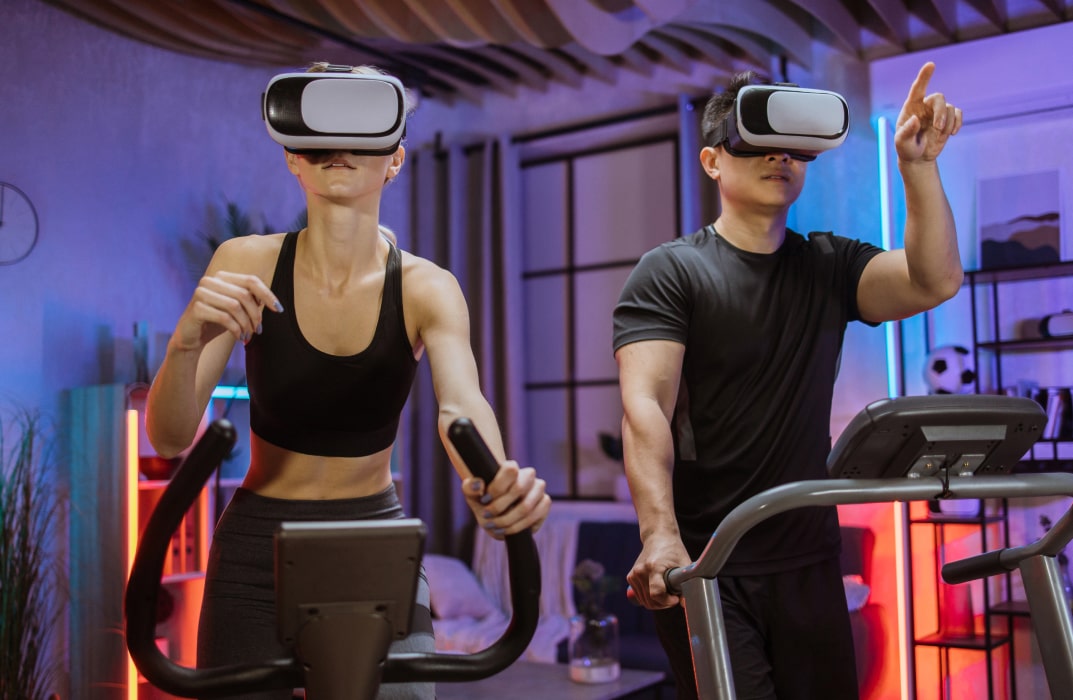Fitness & Technology: 2025 Trends in the Evolving Fitness Industry
In 2025, the fitness industry is undergoing a major transformation driven by innovative technologies and evolving consumer preferences. Hybrid fitness models, which blend in-person and digital experiences, have grown significantly and cater to the changing needs of fitness enthusiasts. These models allow users to enjoy the convenience of digital workouts while still accessing the social and motivational benefits of in-person sessions. These shifts highlight the dynamic nature of the fitness world and how technology plays an integral role in this evolution.

Wearable technology has also become a key component of modern fitness routines. Devices like fitness trackers and smartwatches empower individuals to monitor their physical activities, heart rates, and sleep patterns. These gadgets offer users real-time insights, enabling them to fine-tune their workouts and optimize their health goals. Such technological advancements not only enhance personal fitness journeys but also encourage a more informed approach to health and wellness.
Additionally, the focus on holistic health is becoming increasingly popular, incorporating wellness practices such as mindfulness, nutrition, and recovery-focused services. Businesses in the fitness industry are capitalizing on these trends to provide a comprehensive approach to health that goes beyond physical exercise. By addressing the mental and emotional dimensions of well-being, the industry is broadening its appeal and fostering greater connections with its audience. This move towards a rounded view of health signals a significant shift in how fitness is perceived and pursued today.
The Growth of the Fitness Industry
The fitness industry has transformed significantly in recent years. Digital fitness and hybrid models have redefined how consumers engage with exercise. Key trends show a surge in virtual classes and innovative technology.
Historical Overview and the Digital Revolution
The fitness industry has seen dynamic changes over the decades. In the late 20th century, gyms and fitness clubs flourished as people became more health-conscious. The digital revolution then introduced new possibilities. Online platforms began offering workouts that could be accessed from home. Virtual classes grew in popularity as they provided convenience and variety for fitness enthusiasts.
Digital fitness apps have made it easier for users to track their progress and access personalized workouts. This shift from traditional gyms to digital fitness options has expanded the reach and flexibility of exercise routines. As technology continues to advance, the integration of wearables and smart equipment has become a significant trend.
Current Trends in the Global Fitness Market
In 2025, the global fitness market is characterized by several key trends. Hybrid models, combining in-person and online offerings, have gained popularity. These models cater to the diverse needs of consumers and provide flexibility in how and where they choose to work out. Emerging trends like recovery-focused offerings and innovative technologies continue to shape the market.
The market also sees advancements in wearable technology. Devices such as smartwatches and fitness trackers enhance user experiences and contribute to industry growth. Functional fitness equipment is another rapidly expanding category, reflecting changing consumer preferences towards holistic health and fitness.
Impact of COVID-19 and the Surge in Digital Fitness
COVID-19 had a profound impact on the fitness industry. With lockdowns and social distancing, traditional gym activities faced challenges. This led to a significant rise in digital fitness solutions. Platforms providing virtual classes and at-home workouts became vital for maintaining exercise routines during the pandemic.
The pandemic accelerated the adoption of digital services, highlighting the demand for flexible and convenient options. It also influenced the development of hybrid fitness models, which integrate both online and face-to-face elements. This combination meets consumer demands for versatile and accessible fitness solutions, positioning the industry for future growth.
Wearable Technology and Health Monitoring

Wearable technology has transformed how people track health and fitness. These devices offer real-time data and personalized health insights, empowering users to make informed lifestyle choices.
The Rise of Smartwatches and Fitness Trackers
Smartwatches and fitness trackers have quickly become essential tools for millions. Devices like the Apple Watch and Fitbit provide users with the ability to monitor daily activities, track calories, and measure sleep quality. With sleek designs and intuitive interfaces, these wearables appeal to a wide audience.
The success of smartwatches lies in their versatile functionality. They not only count steps but also offer notifications, GPS mapping, and connectivity with mobile apps. Users can set goals, receive reminders, and compete with friends, making physical activity more engaging and rewarding.
Integration of Health Markers in Wearable Tech
Wearable tech now goes beyond basic fitness tracking by integrating advanced health markers. Heart rate monitors are standard in most devices, offering users insights into cardiovascular health. Some wearables also track oxygen levels, stress indicators, and sleep cycles. These features provide a more comprehensive view of an individual’s health status.
The introduction of technology capable of monitoring electrocardiograms and blood pressure has expanded the role of wearables in healthcare. Such devices alert users to potential health issues, encouraging them to seek medical advice when necessary. This proactive approach empowers users to take charge of their wellbeing.
Wearable Tech for Enhanced Fitness and Wellness
Wearable technology deeply impacts fitness and wellness. Devices offer personalized exercise recommendations and AI-powered coaching to help users optimize workouts. Fitness enthusiasts benefit from real-time analysis and feedback on performance metrics like pace, distance, and heart rate.
Advanced wearables integrate with smartphones to offer tailored workout plans and nutritional advice. This integration allows for a comprehensive approach to health management. Wearables also provide encouragement through reminders and achievement tracking, motivating users to maintain consistent fitness routines and make healthier lifestyle choices.
The Role of Technology in Personalized Fitness

Technology has transformed personalized fitness by offering tailored workout plans and customized nutrition guidance. It uses biometric data to adjust training programs and achieve core fitness goals. This integration creates a more effective and adaptive fitness routine for individuals, meeting their unique needs and preferences.
AI-Powered Personal Trainers and Tailored Workout Plans
AI-powered personal trainers have changed how people approach exercise. These trainers use algorithms to create tailored workout plans based on a person’s fitness level, preferences, and goals. They can adjust the plan as the user progresses, tracking improvements and recalibrating routines to keep them effective.
Many applications and devices rely on this technology to coach users through personalized experiences. AI trainers offer real-time feedback, correcting form and adjusting intensity without needing in-person appointments. This makes personalized fitness plans more accessible, allowing users to work at their own pace and convenience. The flexibility and adaptability of AI technology help individuals maintain consistent progress in achieving their fitness aspirations.
Customized Nutrition Guidance and Fitness Goals
Technology also extends to customized nutrition guidance, an essential part of personalized fitness. It considers personal dietary preferences and restrictions to suggest meals that align with fitness goals. These personalized fitness plans help in balancing calorie intake with exercise output.
Applications provide detailed analysis and track nutrient intake, making it easier to follow specific dietary guidelines. Users receive meal suggestions and learn about portion sizes that suit their workout intensity and daily energy needs. By aligning dietary habits with fitness routines, technology ensures a cohesive approach to health and wellness.
Biometric Data and Adaptive Training Programs
Tracking biometric data plays a crucial role in creating adaptive training programs. Devices like fitness trackers and smartwatches monitor heart rate, sleep patterns, and more. These insights help tailor workouts and recovery plans to optimize performance and minimize injury risk.
Using this data, training schedules adjust dynamically, accommodating lifestyle changes or new fitness targets. This adaptability ensures a more efficient path to achieving wellness objectives. By continually analyzing performance metrics, individuals receive precise recommendations, ensuring every workout is aligned with personal fitness goals. This makes maintaining a personalized fitness regime easier and more effective.
Mental and Holistic Wellness in the Fitness Sector

In 2025, the fitness sector is paying more attention to mental health, stress management, and holistic wellness. With a growing recognition of the mind-body connection, fitness programs now aim to improve not only physical but also emotional and mental well-being. This shift has led to the introduction of numerous innovative approaches and techniques.
The Importance of Mental Health in Physical Fitness
Integrating mental health into physical fitness routines has become essential. Today’s fitness programs recognize that mental health can significantly impact physical performance. As a result, many gym-goers now seek programs that incorporate mental health support, such as counseling services and mindfulness workshops. Personal trainers and coaches often encourage clients to balance intense workouts with practices focused on mental well-being.
Furthermore, these programs often include strategies for coping with stress and anxiety, which positively influence motivation and consistency in exercise routines. As a result, recognizing the impact of mental health on physical performance allows the fitness industry to foster more holistic and supportive environments, ensuring individuals achieve both their physical and emotional goals.
Holistic Approaches to Health and Wellness
The adoption of holistic wellness practices has become evident in fitness trends. Many fitness centers now offer holistic approaches that integrate both physical exercises and mental well-being exercises. This approach recognizes that true wellness requires addressing multiple aspects of health such as diet, sleep, and stress levels.
Practices like yoga, Tai Chi, and meditation are increasingly incorporated into fitness programs to promote both mental clarity and physical health. These activities focus not only on physical strength but on achieving emotional balance and mental peace, ensuring a more rounded approach to health. Facilities offering such comprehensive programs cater to individuals seeking a well-balanced lifestyle that nurtures both the mind and body.
Techniques for Stress Reduction and Brain Health
Stress reduction is a key component of modern fitness regimens. Techniques such as deep breathing exercises, meditation, and progressive muscle relaxation are widely used. They help decrease stress, which is essential for maintaining healthy brain function and emotional well-being. Activities like guided meditation can enhance concentration and improve mood, which in turn positively affects physical performance.
Fitness centers may also utilize emerging technologies like wearable devices to monitor stress levels and suggest appropriate interventions. These devices track physiological indicators such as heart rate and offer insights into stress management. These innovations, along with the integration of mental health practices, highlight a clear commitment to fostering brain health and reducing stress within the fitness industry.
Emerging Technologies and the Future of Fitness
The fitness industry is being transformed by novel technologies. Virtual and augmented reality are creating immersive workout environments, and sustainability initiatives are promoting eco-friendly practices. Additionally, advancements in social fitness experiences are enhancing community engagement. These developments are paving the way for a more personalized and sustainable approach to fitness.
Virtual and Augmented Reality in Fitness Programs
Virtual reality (VR) and augmented reality (AR) are reshaping how people engage in fitness. VR allows users to enter completely virtual worlds where they can, for example, cycle through picturesque landscapes or take part in interactive games. AR, on the other hand, overlays digital elements onto the real world, offering real-time feedback and guidance.
With these technologies, workouts are no longer confined to gyms. They provide motivation and entertainment, making exercising more enjoyable. Companies are developing AR fitness programs that enhance traditional fitness routines with engaging features. For those seeking new experiences, VR and AR offer fresh, engaging ways to stay in shape.
Sustainability Initiatives and the Environment
With growing awareness of environmental issues, sustainability in fitness has gained importance. Fitness centers are adopting eco-friendly practices, such as energy-efficient lighting and sustainable materials. Initiatives also focus on reducing waste and promoting green energy.
These changes are not just limited to fitness facilities. Equipment manufacturers are also creating products that are eco-conscious. For instance, treadmills that convert kinetic energy to electricity during workouts are becoming popular. These sustainability initiatives help reduce the carbon footprint and appeal to environmentally conscious consumers, focusing on creating a more sustainable future of fitness.
Advancements in Community and Social Fitness Experiences
Fitness communities are evolving with technology, enhancing how people connect over shared wellness goals. Apps and platforms enable users to join virtual groups, making it easy to find workout partners or compete in challenges. This fosters a sense of unity and accountability.
Social media integration in fitness apps allows users to share achievements with friends, motivating each other. Platforms also offer live-streamed classes, bringing group fitness experiences to home workouts. These advancements make fitness more accessible and engaging, creating a supportive and interactive community environment.
Frequently Asked Questions
The fitness industry of 2025 is being reshaped by advances in technology. Innovations like wearable devices, AI-powered coaching, virtual reality, data analytics, nutrition tech, and mobile apps are transforming how people work out and engage with fitness.
What innovations in wearables are influencing workout routines in 2025?
Wearable fitness technology is on the rise, with devices like fitness trackers and smartwatches capturing real-time data such as heart rate and sleep patterns. These tools empower users to monitor and adjust their workouts effectively, contributing to a more personalized fitness experience. The market for wearables is expected to grow significantly, reaching $62.82 billion by 2025.
How are AI-powered fitness coaches impacting personal training?
AI-powered fitness coaches offer tailored exercise programs by analyzing user data and providing personalized feedback. This technology enhances the effectiveness of workouts by adjusting routines based on progress and specific goals. The ability to deliver insights and adapt in real time makes AI coaching a valuable asset for fitness enthusiasts seeking personalized guidance.
What role does virtual reality play in fitness regimens today?
Virtual reality (VR) in fitness offers immersive workout experiences, making exercise more engaging and enjoyable. Users can take part in virtual classes or scenarios that motivate them to exercise regularly. VR technology helps create a new level of interaction, bringing fresh and exciting dimensions to traditional fitness routines.
How has data analytics improved personalized fitness plans?
Data analytics in fitness allows for the creation of highly personalized exercise plans by examining data collected from individual workouts. This information helps in tracking progress, identifying areas for improvement, and setting realistic goals. As a result, individuals can achieve their fitness objectives more efficiently and effectively.
What trends are emerging in fitness nutrition and supplement technology?
Advancements in nutrition and supplement technology are providing more targeted solutions tailored to individual needs. Products now include personalized vitamins and supplements formulated based on genetic and lifestyle data. Such innovations help optimize nutrition for better health and performance.
In what ways have mobile fitness applications altered user engagement?
Mobile fitness applications offer convenience and access to a wide range of workouts, tracking tools, and social features. These apps motivate users by providing an interactive platform for setting goals, competing with friends, and tracking achievements. As a result, fitness apps have become an integral part of many individuals’ fitness journeys.






